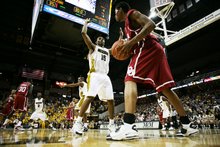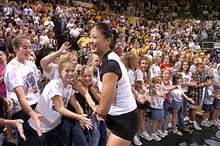It's time once again for me to interest only myself by delving into game stats from a different angle...
Success Rate by Quarter
Once again, “success” is defined as follows: 40% of needed yardage on 1st down, 70% of needed yardage on 2nd down, or 100% of needed yardage on 3rd or 4th down. This looks at the rate of success for each team by each quarter. Its goal is to see how the game flowed from one quarter to another.
Q1: MU 55.6%, WMU 43.8%
Q2: WMU 50.0%, MU 43.5%
Q3: WMU 35.3%, MU 30.4%
Q4: MU 69.6%, WMU 65.4%
GAME: WMU 50.6%, MU 49.4%
Alarming? Not so much. Here’s the success rate for only plays taking place when the score was within 16 points or less (i.e. two possessions):
Q1: MU 55.6%, WMU 43.8%
Q2: MU 57.1%, WMU 25.0%
Q3: N/A (the game was never within 16 points)
Q4: MU 83.3%, WMU N/A (MU got the ball up 14 and immediately drove down for a TD)
GAME-CLOSE: MU 61.3%, WMU 40.0%
Again, this shows what we’ve been seeing all season—Mizzou takes its foot off the gas when up big. And again, this problem could be worse...we could not be up huge in every game.
For the season...
Q1: Mizzou 47.8%, Opp 39.0%
Q2: Opp 53.2%, Mizzou 48.5%
Q3: Opp 50.0%, Mizzou 48.3%
Q4: Opp 49.3%, Mizzou 48.3%
GAME: Opp 48.7%, Mizzou 48.2%
For the season, in close games...
Q1: Mizzou 47.8%, Opp 39.0%
Q2: Mizzou 52.0%, Opp 48.6%
Q3: Mizzou 75.0%, Opp 25.0%
Q4: Mizzou 41.9%, Opp 37.5%
GAME-CLOSE: Mizzou 49.4%, Opp 40.8%
Now you see why I only look at stats when the game is within two possessions. That’s what I’ll solely observe for the rest of these numbers.
QB Success Rate
This looks at the success rate of every play in which a specific QB takes the snap.
Mizzou
Chase Daniel: 19-for-30 (63.3%) (SEASON: 81-for-165 (49.1%))
Martin Rucker: 0-for-1 (0.0%) (SEASON: 4-for-6 (66.7%))
TEAM: 19-for-31 (61.3%) (SEASON: 85-for-172 (49.4%))
WMU
Tim Hiller: 8-for-20 (40.0%)
Run Success Rate
Mizzou
Tony Temple: 6-for-6 (100.0%) (SEASON: 11-for-32 (34.4%))
Jeremy Maclin: 2-for-4 (50.0%) (SEASON: 5-for-7 (71.4%))
Chase Daniel: 2-for-2 (100.0%) (SEASON: 8-for-17 (47.1%))
Martin Rucker: 0-for-1 (0.0%) (SEASON: 3-for-5 (60.0%))
TEAM: 10-for-13 (76.9%) (SEASON: 27-for-66 (40.9%))
WMU
West: 2-for-6 (33.3%)
Bonds: 1-for-4 (25.0%)
TEAM: 3-for-10 (30.0%) (OPPONENTS, SEASON: 19-for-50 (38.0%))
Temple and MU's rates are slowly improving from the disaster that was the Illinois game.
Receiver Success Rate
Mizzou
Jeremy Maclin: 4-for-4 (100.0%) (SEASON: 10-for-11 (90.9%))
Martin Rucker: 2-for-4 (50.0%) (SEASON: 14-for-18 (77.8%))
Will Franklin: 1-for-1 (100.0%) (SEASON: 10-for-13 (76.9%))
Tommy Saunders: 1-for-1 (100.0%) (SEASON: 4-for-5 (80.0%))
Jared Perry: 1-for-1 (100.0%) (SEASON: 3-for-4 (75.0%))
Jimmy Jackson: 0-for-1 (0.0%) (SEASON: 0-for-1 (0.0%))
TEAM: 9-for-12 (75.0%) (SEASON: 58-for-74 (78.4%))
WMU
Ledbetter: 1-for-2 (50.0%)
West: 1-for-2 (50.0%)
Martin: 1-for-1 (100.0%)
Middleton: 1-for-1 (100.0%)
Simmons: 1-for-1 (100.0%)
Bonds: 0-for-1 (0.0%)
TEAM: 5-for-8 (62.5%) (OPPONENTS, SEASON: 30-for-38 (78.9%))
Line Yards
Again, here are the rules for Line Yards, an attempted measure of O-line (and D-line) effectiveness:• For a play that resulted in negative yards, the O-line is granted 120% of the effort (i.e. a 3-yard loss would be a 3.6-yard loss for the O-line).
As a whole, it makes a lot more sense in regard to running plays (the line’s responsible for creating lanes necessary for the RB moving up the field) than passing plays (most of the time, the line’s only responsible for the QB getting the pass off comfortably).
• For a play that resulted in a 0-4 yard gain, the O-line is granted 100%.
• For a play that resulted in a 5-10 yard gain, the O-line is granted 50% of the yards over 4 (i.e. an 8-yard gain would be a 6-yard gain for the O-line).
• For a play that resulted in a 10+ yard gain, the O-line get no extra credit—by that point, the runner is into the secondary, and the line won’t get much chance to block. Therefore (if the math in my head is correct), the most credit an O-line can get is 7.5 yards.
Mizzou-WMU
Mizzou
13 rushes, 64 yards (4.92/carry)
31 total plays, 130 yards (4.19/play)
WMU
10 rushes, 30.8 yards (3.08/carry)
20 total plays, 52.1 yards (2.61/play)
Season
Mizzou
66 rushes, 185.6 yards (2.81/carry)
173 plays, 552.2 yards (3.19/play)
Opponents
50 rushes, 144.1 yards (2.88/carry)
120 plays, 319.9 yards (2.67/play)
And as a point of reference...
2006 Conference Numbers
Mizzou
251 rushes, 687.5 yards (2.74/carry)
551 plays, 1628.5 yards (2.96/play)
Opponents
306 rushes, 1006.2 yards (3.29/carry)
548 plays, 1644.4 yards (3.00/play)
You would want your non-conference numbers to be better than last year’s conference numbers, and they are across the board. How that translates to 2007 conference numbers, we’ll have to wait and see. Either way, though, the line yards figures show improvement against WMU as compared to previous weeks...one would hope so, as WMU likely isn’t as good as UI or Ole Miss were.
Defensive Success Rates
I’m going to do this one a little differently this week. The last couple of weeks, I’ve laid out these stats as follows: total tackles (when the game was within two possessions), the number of those tackles that resulted in a successful play for the offense, and the overall success rate. That was fine, except it was a little confusing, as the lower the success rate was for a defender, the better. It makes more sense for a higher number to signify success (this isn’t golf), so I’m now defining the “successful” plays listed below as whether a play was successful for the defense (i.e. was not a successful play for the offense). Make sense? I’m sure it does. So now, if a defensive player has a 100% success rate, that’s good.
And as I’ve mentioned before, you have to kind of figure that the DL will have a better rate than the LB’s, and the LB’s better than the DB’s, just thinking about how close to the line of scrimmage (and the ‘success’ line) they line up on a given play.
MIZZOU VS WMU
Defensive Line
Lorenzo Williams – 3.5 tackles, 3.5 successful (100.0%)
Tommy Chavis – 1.0 tackles, 1.0 successful (100.0%)
Charles Gaines – 1.0 tackles, 1.0 successful (100.0%)
Ziggy Hood – 0.5 tackles, 0.0 successful (0.0%)
TOTAL – 6.0 tackles, 5.5 successful (91.7%)
Linebackers
Sean Weatherspoon – 1.0 tackles, 1.0 successful (100.0%)
Brock Christopher – 2.0 tackles, 1.5 successful (75.0%)
TOTAL – 3.0 tackles, 2.5 successful (83.3%)
Defensive Backs
Castine Bridges – 1.5 tackles, 1.0 successful (66.7%)
William Moore – 2.0 tackles, 1.0 successful (50.0%)
Justin Garrett – 0.5 tackles, 0.0 successful (0.0%)
Carl Gettis – 2.0 tackles, 0.0 successful (0.0%)
Pig Brown – 1.5 tackles, 0.0 successful (0.0%)
Hardy Ricks – 1.5 tackles, 0.0 successful (0.0%)
TOTAL – 9.0 tackles, 2.0 successful (22.2%)
SEASON
Defensive Line
Lorenzo Williams – 8.0 tackles, 8.0 successful (100.0%)
Jaysen Corbett – 1.0 tackles, 1.0 successful (100.0%)
Charles Gaines – 1.0 tackles, 1.0 successful (100.0%)
Tommy Chavis – 2.0 tackles, 1.5 successful (75.0%)
Stryker Sulak – 1.5 tackles, 1.0 successful (66.7%)
Ziggy Hood – 3.5 tackles, 1.0 successful (28.6%)
TOTAL – 17.0 tackles, 13.5 successful (79.4%)
Linebackers
Brock Christopher – 13.0 tackles, 8.5 successful (65.4%)
Sean Weatherspoon – 11.5 tackles, 7.0 successful (60.9%)
Van Alexander – 3.0 tackles, 0.5 successful (16.7%)
TOTAL – 27.5 tackles, 16.0 successful (58.2%)
Defensive Backs
Castine Bridges – 1.5 tackles, 1.0 successful (66.7%)
Justin Garrett – 1.0 tackles, 0.5 successful (50.0%)
Pig Brown – 9.5 tackles, 4.0 successful (42.1%)
William Moore – 9.0 tackles, 3.0 successful (33.3%)
Hardy Ricks – 7.0 tackles, 2.0 successful (28.6%)
Carl Gettis – 6.0 tackles, 0.0 successful (0.0%)
Del Howard – 3.0 tackles, 0.0 successful (0.0%)
Darnell Terrell – 2.5 tackles, 0.0 successful (0.0%)
TOTAL – 39.5 tackles, 10.5 successful (26.6%)
The only comments I have about this are as follows:
• All Lorenzo Williams does is make big plays. He has well over half of the D-Line’s ‘successful’ plays for the season. That’s both good and bad, I think. I’ll get into that one more later.
• We really, really, really need for three guys to start making positive contributions: Ziggy Hood, Stryker Sulak and Van Alexander. Hood has officially made 1.0 successful plays this year, not counting his 2nd quarter fumble recovery against WMU (which does factor into consideration a bit). Sulak caused that 2nd quarter fumble and was a lot more noticeable against WMU, though all of his plays came with Mizzou up comfortably. Alexander, meanwhile, is leading the team (by my count, anyway) in missed arm tackles, while his ‘success rate’ is significantly far below that of Weatherspoon and Christopher. We have two-thirds of a successful LB corps, but that’s not nearly enough. Either Alexander needs to improve, or somebody like Luke Lambert needs to step up and steal some playing time.
• Pig Brown hasn’t done much since the Illinois game. He makes some nice hits, but they’re all coming after big gains.
Turnover Costliness
The super-primitive formula for this can be found here. As always, if you have a better idea for this formula, let me know. One of these days, I’ll get a response to that request.
WMU1: Q1, 7-0 MU, 3rd and 5 from the WMU 42 (Christopher INT) – 3 points
MU1: Q2, 21-3 MU, 3rd and 10 from the MU 35 (Gebhart INT) – 3 points
WMU2: Q2, 28-3 MU, 1st and 10 from the MU 45 (Sulak FF, Hood FR) – 1 point
MU2: Q3, 31-3 MU, 3rd and 7 from the MU 30 (C.J. INT for TD) – automatic 5 points
Total: MU 6 points on 2 turnovers (3.0 avg), WMU 4 points on 2 turnovers (2.0 avg)
Season: MU 15 points on 4 turnovers (3.8 avg), Opponents 36 points on 9 turnovers (4.0 avg).
So I guess you can say that not only does MU have a +5 turnover margin for the year, they have a +21 turnover costliness margin.
Mizzou Statistical MVPs
Offensive: You don’t need to delve to deeply into the box score to notice Jeremy Maclin’s diverse and effective day. He did a little of everything—run, catch, return kicks—and he did it all effectively. Martin Rucker had an amazing day as well, but more of his came when the game was a little less tight.
Defensive: Brock Christopher’s been the defense’s rock this year, and he showed it here. He only made 1.5 ‘successful’ defensive plays (when the game was within 2 possessions), but he also had an INT (worth 3 points). That bumps him ahead of Lorenzo Williams and his 3.5 successful plays.
For the season...
Offensive: Really, the only guys who have brought their A-game all three games so far are Chase Daniel, Maclin, and Rucker. Compared to others at his position, Rucker is by far the biggest success of the three guys, but I really can’t give a ‘season MVP’ award to anybody other than Chase Daniel.
Defensive: Just as with the WMU game, Brock Christopher gets the slight nod over Lorenzo Williams for the season because of the successful plays/turnovers combination...and because of the D-line's overall ineffectiveness. Williams is the Mizzou defense’s version of Cris “All he does is catch TD’s” Carter—all he does is make big plays. And as with that original quote about Carter, that’s not a 100% good thing...at least not when compared to the defense as a whole.
The D-line needs to make more plays, period, if this defense is going to play well enough for Mizzou to win the Big 12 North. I’m sure Williams could be doing more, but as I said above...he’s made 8 of the D-Line’s 13 successful plays. Guys like Hood, Sulak, etc., need to do something...anything. Sulak had a nice game against WMU, though most of it came with Mizzou up comfortably. Hopefully that’s a sign of things to come, though.
Wednesday, September 19, 2007
Mizzou-WMU: Beyond the Box Score
Posted by
The Boy
at
9:09 AM
![]()
Labels: Beyond the Box Score, Mizzou football
Subscribe to:
Comment Feed (RSS)






|